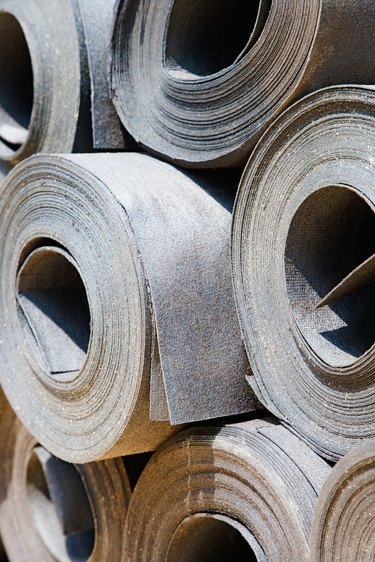
Swathes of rolled roofing form a relatively flat, smooth surface over a roof deck, which is ideal for treatment with viscous membranes, such as elastomeric coatings. Typically applied with trowel, brush or roller, elastomeric membranes form a flexible, waterproof covering over roof surfaces. However, the efficacy of elastomeric compounds depends on installation circumstances and surface preparation. If you learn about the characteristics and installation requirements of elastomeric coatings, you can determine when and where to apply them.
About Rolled Roofing
Video of the Day
The term "rolled roofing" generally refers to a product called "mineral paper," which builders use as a primary roof covering on sloped, residential roofs. Rolled roofing consists of asphalt-bound sheets coated with sand-like granules. Unlike built-up or hot mop roofs, mineral paper roofs do not require a coating of waterproof membrane. However, if mineral paper roofs develop widespread leaks, a coating of waterproof membrane, such as an elastomeric coating, can successfully encapsulate the roof surface and extend the roof covering's life.
Video of the Day
About Elastomeric Coating
The suggestion of elasticity in elastomeric coating's name refers to the compound's flexibility after curing. Usually composed of plastic resins, elastomeric coatings have a viscous consistency, similar to household glue or roof patching compound. Unlike glue and roof patch, elastomeric roof compounds never become brittle, but always remain slightly rubbery and flexible. The compounds' flexibility reduces cracking and splitting by allowing them to expand and contract with the roof's natural movement. Many elastomeric coatings are reflective or available in light colors, which potentially reduces heat gain at the roof surface.
Application Tools
Both manually operated hand tools and power tools are suitable for applying elastomeric roof coatings. For large-scale projects, roof repair professionals apply elastomeric coatings with industrial-strength paint sprayers. While still wet, many elastomeric coatings clean up with standard soap and water. However, allowing the compound to dry within a paint sprayer causes clogs or damages sprayer components. Common hand tools used to apply elastomeric coatings include paint rollers, paint brushes and hand trowels.
Applications of Elastomeric Roof Coating
Most elastomeric coating manufacturers recommend their products for both temporary and permanent repairs. Additionally, elastomeric compounds are suitable for both small areas, also called "spot-repairs," and whole-roof coats. Many elastomeric coatings are designed to cure under wet conditions. If your compound is designed for wet applications, you can use it to patch roof leaks during prolonged rain. In addition to rolled roofing, elastomeric coating compounds often adhere to metal and masonry surfaces. Therefore, you can use many elastomeric compounds to patch leaks in metal flashing or the joints between flashing and adjacent masonry surfaces, such as brick or concrete walls.